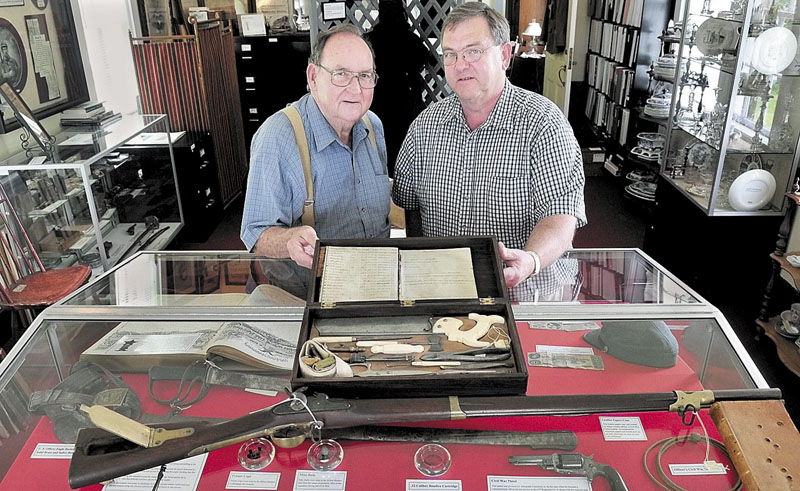SKOWHEGAN — One-hundred and fifty years ago next week, a divided nation was cast into the first significant conflict of the American Civil War at a place Union forces called Bull Run and the Confederates called Manassas.
Three young men from Skowhegan were among the Union ranks that day in Virginia — Samuel F. Emerson, Jefferson Savage, and W. H. Weston. All three men returned home, safe and sound.
Their story and others from the Civil War are part of a new featured exhibit called “Our Connections with the Civil War” on display this summer at the Skowhegan History House Museum & Research Center, 66 Elm St.
The exhibit opened to the public Friday and a grand opening is set for 7 p.m. Thursday.
Skowhegan’s Civil War exhibit is part of a wider regional event called “Central Maine Serves,” which includes programs on servicemen and their communities this summer at eight separate locations.
The collaboration of museums and libraries is sponsored by the Central Kennebec Heritage Council.
Museum curators and volunteers in Skowhegan have pulled together all the Civil War-related artifacts in the museum’s vast collections that pertain to Skowhegan’s connections to the Civil War, said Melvin Burnham, museum director.
The new featured exhibit includes pieces in the Lt. Alexander Crawford Jr. collection, a Civil War rifled musket with Remington cartridges, swords and Grand Army of the Republic personal war sketches.
The exhibit also includes Dr. Wilbur’s Civil War surgeon’s kit, literature and newspaper clippings of the period, fractional currency, Civil War soldiers’ pin-ups and love letters, as well as a multitude of other interesting pieces, Burnham said.
On July 21, 1861, the First Battle of Bull Run was fought with a Union army consisting of 28,000 men, commanded by Gen. Irvin McDowell and 33,000 Confederates under Gen. P.G.T. Beauregard.
“It was a very, very important battle,” Skowhegan museum curator Lee Granville said. “It was the first major battle that either side had seen. Thousands of men actually died in this engagement — for both sides it was a revelation as to what was going to happen in the future.
“A lot of the units were enlisted for 90 days, thinking it would be all over in three months, and of course, that didn’t happen. The war lasted almost four years exactly to the day.”
The Union army, under pressure to crush the rebellion in the South, marched toward Richmond, but met the Confederate forces coming north from Manassas, a Southern base, according to the website library.thinkquest.org.
At the beginning of the five-hour battle, the Union soldiers had the Confederates on the retreat, except for one brigade commanded by Gen. Thomas Jackson. Jackson’s ability to hold his ground and his stubbornness reminded his men of a stone wall, hence the nickname “Stonewall” Jackson.
The battle proved that this was not going to be a one-sided war for either side, as was predicted. The casualties soared to 2,900 killed, wounded, captured or missing for McDowell’s army and 2,000 for Beauregard’s. The battle spurred a sense of victory in the South, pushing them on — and in the North an urge for revenge.
And, like many of the soldiers at the First Battle of Bull Run, the three Skowhegan men were young and not battle-tested, Granville said.
“With boyish characteristics I began to think of home and how quiet everything was there on this sabbath evening,” Samuel Emerson said in a story published in the July 27, 1911, edition of The Independent Reporter of Skowhegan, on display at the museum. “Not quite three months from the parental roof and I was in the throes of terrible, devastating war and experiencing its awful realities.”
Doug Harlow — 474-9534
dharlow@centralmaine.com
Send questions/comments to the editors.




Comments are no longer available on this story